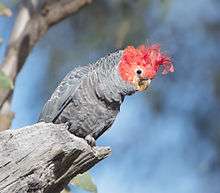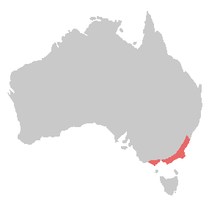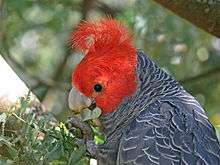Gang-gang cockatoo
| Gang-gang cockatoo | |
|---|---|
 | |
| Adult male in the Australian Capital Territory | |
| Scientific classification | |
| Kingdom: | Animalia |
| Phylum: | Chordata |
| Class: | Aves |
| Order: | Psittaciformes |
| Superfamily: | Cacatuoidea |
| Family: | Cacatuidae |
| Subfamily: | Cacatuinae |
| Tribe: | Cacatuini |
| Genus: | Callocephalon Lesson, 1837 |
| Species: | C. fimbriatum |
| Binomial name | |
| Callocephalon fimbriatum (Grant, 1803) | |
 | |
| Range of C. fimbriatum | |
The gang-gang cockatoo (Callocephalon fimbriatum) is found in the cooler and wetter forests and woodlands of Australia, particularly alpine bushland. Mostly mild grey in colour with some lighter scalloping (more pronounced and buffy in females), the male has a red head and crest, while the female has a small fluffy grey crest. It ranges throughout south-eastern Australia. The gang-gang cockatoo is the faunal emblem of the Australian Capital Territory. It is easily identified by its distinctive call, which is described as resembling a creaky gate, or the sound of a cork being pulled from a wine bottle.
The name gang-gang comes from a New South Wales Aboriginal language, probably from one of the coastal languages, although possibly from Wiradjuri. It is probably an onomatopoeic name.[2]
Breeding
Unlike most other cockatoos, gang-gangs nest in young, solid trees, the females using their strong beaks to excavate nesting cavities. Also breed in the canopy of most trees. They are sexually dichromatic.
Status
Loss of older, hollow trees and loss of feeding habitat across south-eastern Australia through land clearing has led to a significant reduction in the numbers of this cockatoo in recent years. As a result, the gang-gang is now listed as vulnerable in New South Wales.[3]
Taxonomy
The gang-gang cockatoo was most often allied with the white cockatoos of the genus Cacatua. This has always been controversial due to the unusual appearance and coloration of the bird, especially its sexual dichromatism. New research has finally resolved the matter, with the gang-gang cockatoo being recognized as a distinctive early offshoot of the calyptorhynchine (dark) cockatoos.[4] Considering the robust phylogeny of the cockatoos now established, a comparison of characters gained and lost during the evolution of cockatoos suggests that the gang-gang cockatoo—while of course much changed and adapted during the perhaps 20 million years since its last common ancestor with any other living species lived—is probably still very similar in overall appearance to how the earliest cockatoos would have looked, and certainly the most primitive-looking of the species alive today.
Gallery
 A female gang-gang cockatoo eating peppercorns
A female gang-gang cockatoo eating peppercorns Female
Female_-Blue_Mountains-8.jpg) Male in the Blue Mountains
Male in the Blue Mountains Male eating Acacia baileyana seeds
Male eating Acacia baileyana seeds_-NSW_-Australia-8.jpg) Two immature birds at New Buildings, NSW, Australia. The male is on the left and the female on the right.
Two immature birds at New Buildings, NSW, Australia. The male is on the left and the female on the right.
References
- ↑ BirdLife International (2012). "Callocephalon fimbriatum". IUCN Red List of Threatened Species. Version 2013.2. International Union for Conservation of Nature. Retrieved 26 November 2013.
- ↑ Gray, Jeannie; Fraser, Ian (2013). Australian Bird Names: A Complete Guide. Collingwood, VIC, Australia: CSIRO Publishing. p. 127.
- ↑ Hughes, Lesley (2005). "Gang-gang Cockatoo - vulnerable species listing". NSW Scientific Committee - final determination. New South Wales Office of Environment & Heritage. Retrieved 21 November 2011.
- ↑ Brown, D.M.; Toft, C.A. (1999). "Molecular systematics and biogeography of the cockatoos (Psittaciformes: Cacatuidae)". Auk. 116 (1): 141–157. doi:10.2307/4089461. JSTOR 4089461.
- Flegg, Jim (2002). Photographic Field Guide: Birds of Australia. Sydney & London: Reed New Holland. ISBN 1-876334-78-9.
External links
| Wikimedia Commons has media related to Callocephalon fimbriatum. |
| Wikispecies has information related to: Callocephalon fimbriatum |
| Look up Gang-gang cockatoo in Wiktionary, the free dictionary. |
- Gang-gang Cockatoo Species Profile at World Parrot Trust Parrot Encyclopedia
- BirdLife species factsheet for Callocephalon fimbriatum
- Gang-gang cockatoo on the Atlas of Living Australia
- "Callocephalon fimbriatum". Avibase.

- "Gang-gang cockatoo media". Internet Bird Collection.
- Gang-gang cockatoo photo gallery at VIREO (Drexel University)
- Interactive range map of Callocephalon fimbriatum at IUCN Red List maps
- Audio recordings of Gang-gang cockatoo on Xeno-canto.
